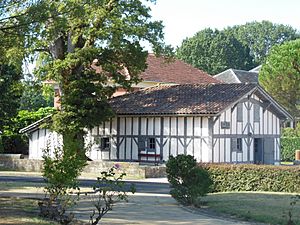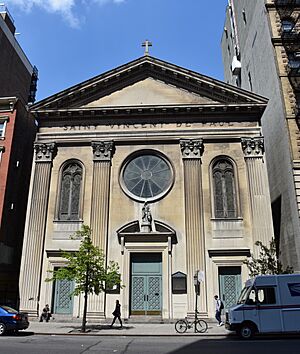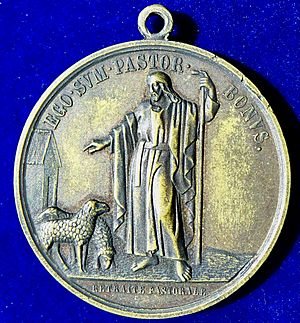Vincent de Paul facts for kids
Quick facts for kids SaintVincent de Paul C.M. |
|
|---|---|
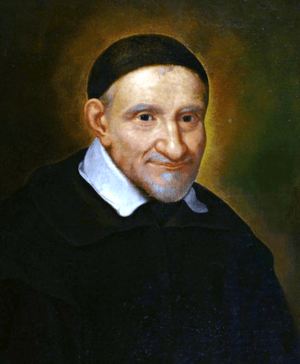
Seventeenth-century portrait of Vincent by Simon François de Tours
|
|
| Priest and founder | |
| Born | 24 April 1581 Saint-Vincent-de-Paul, Guyenne and Gascony, Kingdom of France |
| Died | 27 September 1660 (aged 79) Paris, Kingdom of France |
| Venerated in | |
| Beatified | 13 August 1729, Rome, Papal States by Pope Benedict XIII |
| Canonized | 16 June 1737, Rome, Papal States by Pope Clement XII |
| Major shrine | St. Vincent de Paul Chapel, 95, Rue de Sèvres, Paris, France |
| Feast | 27 September 19 July (Roman Calendar, 1737–1969) |
| Patronage |
|
Saint Vincent de Paul (born April 24, 1581 – died September 27, 1660) was a French Catholic priest. He is famous for helping people who were poor and in need. He founded groups that still help people today. Vincent is honored as a saint in the Catholic Church and the Anglican Communion.
Contents
Early Life and Learning
Vincent de Paul was born in 1581 in a small village called Pouy, in France. His parents, Jean and Bertrande, were farmers. Vincent was the third of six children.
Even as a child, he showed a talent for reading and writing. He also helped his family by herding their animals. When he was 15, his father sent him to a seminary to study to become a priest. His father paid for this by selling their oxen.
Vincent studied for three years at a college in Dax, France. He then went to the University of Toulouse to study theology. He paid for his studies by tutoring other students.
He became a priest on September 23, 1600, when he was 19 years old. This was younger than the usual age required at the time. He continued his studies and later earned degrees in theology and church law.
A Journey and Capture
Stories about Vincent de Paul tell of him being captured by pirates. This happened while he was traveling from Marseilles in 1605. He was on his way back from selling some property.
According to these stories, pirates took him to Tunis. There, he was sold as a captive. He spent two years in this situation.
His first owner was a fisherman, but Vincent got seasick. So, he was soon sold again. His next owner was a doctor and inventor. Vincent learned about his master's special remedies.
Later, Vincent was sold a third time. His new owner was a former Catholic priest who had converted to Islam. This man's wife became interested in Vincent's Christian faith. She convinced her husband to return to France with Vincent. They secretly escaped by boat in 1607. Some historians have questioned parts of this story, but it is a traditional part of his life.
Returning to France
After his escape, Vincent went to Rome. He continued his studies there until 1609. Then, he was sent back to France.
In France, he met Pierre de Bérulle, who became his spiritual guide. Vincent was naturally a bit quick-tempered. But he slowly learned to be more caring towards others.
In 1612, he became a parish priest in Clichy. Less than a year later, he was called to Paris. He worked as a chaplain and tutor for the wealthy Gondi family.
Vincent had first wanted a comfortable life as a priest. However, his heart changed after hearing a dying farmer's confession. He realized how much help poor people needed.
The Countess de Gondi helped him. She convinced her husband to support a group of missionaries. These missionaries would work among poor farmers and people in the countryside.
Starting New Groups
In 1617, Vincent began to organize wealthy women in Paris. They collected money for missionary projects. They also started hospitals and raised funds for war victims. They even helped free 1,200 galley slaves from North Africa.
This work with women led to the creation of the Daughters of Charity of Saint Vincent de Paul. This group, co-founded with Louise de Marillac, helps people in need.
In 1622, Vincent became a chaplain for galley slaves. He worked in Paris among these prisoners. Later, he became the leader of the Congregation of the Mission. This group is also known as the "Vincentians" or "Lazaristes."
These priests made promises of poverty, chastity, and obedience. They dedicated themselves to helping people in smaller towns and villages. Vincent also helped train clergy and set up seminaries.
Vincent de Paul passed away in Paris on September 27, 1660.
The Society of Saint Vincent de Paul
Saint Vincent de Paul is known as the patron saint of all charity work. Many groups have been inspired by his teachings. These groups are part of a larger family called the Vincentian Family.
One of the most well-known groups is the Society of Saint Vincent de Paul. French university students started this charity in 1833. It was led by Frederic Ozanam. This society helps the poor and is active in 153 countries today.
Honoring Saint Vincent
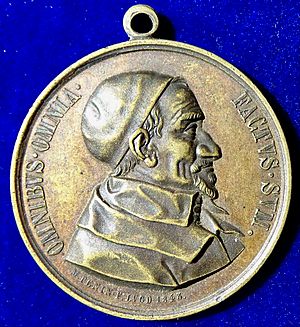
In 1705, the process to make Vincent a saint began. He was declared "blessed" by Pope Benedict XIII in 1729. He became a saint almost eight years later, in 1737, by Pope Clement XII.
His body was examined in 1712, 53 years after his death. Reports said that only his eyes and nose showed some decay. However, when it was examined again in 1737, it had decayed more due to a flood. His bones are now in a wax figure. This figure is displayed in a glass case in Paris, at the Saint Vincent de Paul Chapel. His heart is also preserved and displayed in a chapel in Paris.
His feast day, a special day to remember him, is September 27. This date was chosen because it was his death day.
Vincent's Legacy Today
Many universities and schools in the United States are named after Saint Vincent de Paul. These include Niagara University, St. John's University, and DePaul University. These schools were founded by the Vincentian priests.
Many churches and parishes around the world are also dedicated to him. For example, there are churches in Los Angeles, Chicago, and Houston. High schools like DePaul College Prep in Chicago also carry his name.
In San Diego, California, there is a campus called St. Vincent de Paul Village. It provides affordable homes and support for people in need. In New Zealand, the Society of St Vincent de Paul helps create a more fair society.
A large care facility for elderly people in Malta is named after him. In the Philippines, a church in Manila and two colleges honor him as their patron saint.
See Also
 In Spanish: Vicente de Paúl para niños
In Spanish: Vicente de Paúl para niños
- List of Superior Generals of the Congregation of the Mission
- List of Catholic saints
- List of slaves
- Saint Vincent de Paul, patron saint archive
- Union chrétienne de Saint-Chaumond (Poitiers) – Cofounded by St. Vincent de Paul


